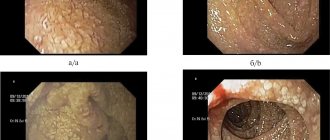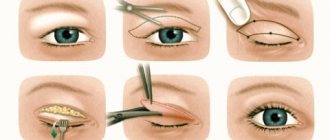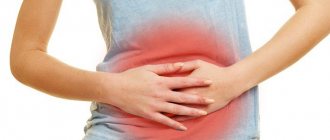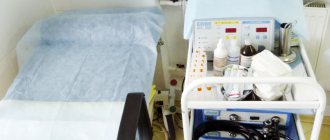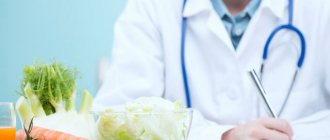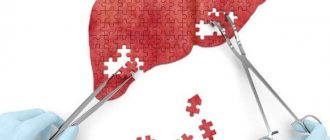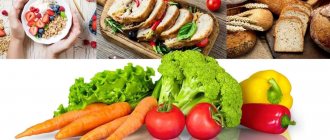| Make an appointment | Make an appointment by calling +7 (812) 600-67-67 or filling out the online form - the administrator will contact you to confirm your appointment |
UNION CLINIC guarantees complete confidentiality of your request.
Ultrasound examination of the gallbladder - 600 rubles.
Ultrasound of the liver and gallbladder - 1000 rubles.
Cholecystitis is inflammation of the gallbladder. There are acute and chronic courses of this disease.
Acute cholecystitis ranks second after appendicitis among acute diseases of the abdominal organs.
Chronic cholecystitis, along with peptic ulcer disease, is one of the most common diseases of the digestive system with a tendency to increase incidence. In most cases, inflammation of the gallbladder is caused by the presence of calculi (stones) in it, and only 15–20% are due to acalculous cholecystitis. At a young age, non-calculous (stoneless) cholecystitis predominates; at 30–50 years of age, calculous cholecystitis, which is also called stone cholecystitis, occurs 2.5 times more often.
Cholecystitis is a disease in the development of which many causes may be involved. The main reasons for its development :
- nutritional - disturbance of the rhythm of nutrition, abuse of fatty foods, fried foods, and alcohol;
- neuropsychic;
- immune;
- allergic;
- hormone;
- anomalies in the development of the gallbladder;
- the presence of foci of infection in the body;
- hereditary.
Mechanisms of formation of the inflammatory reaction in the wall of the gallbladder:
- stretching of the bladder, increased pressure in the cavity of the gallbladder, impaired blood supply, leading to the development of ischemia (oxygen starvation) of the gallbladder wall;
- the damaging effect of toxic substances contained in bile, supersaturated with bile acids, cholesterol, lysolecithin);
- the damaging effect of bacterial toxins (dangerous waste products of microbes);
- the damaging effects of allergic reactions, especially food allergies.
Infection plays a major role in the mechanisms of development of cholecystitis in adult patients:
- conditionally pathogenic microflora (Escherichia coli, Streptococcus faecalis, Klebsiella spp.), which is sown 2.5 times more often than pathogenic;
- pathogenic microflora (shigella and salmonella);
- viral infection (cytomegalovirus, enteroviruses, hepatitis B and C viruses);
- parasitic infections (giardiasis, opisthorchiasis, ascariasis).
There are three ways of infection entering the gallbladder and bile ducts: lymphogenous (through the vessels of the lymphatic system), hematogenous (through blood vessels from foci of infection in the body), ascending (from the duodenum). There are: A. Acute cholecystitis :
- stone;
- stoneless.
B. Chronic cholecystitis (stone or non-stone). Including:
- without violations of the basic functions of the gallbladder;
- with impaired concentration function of the gallbladder;
- with impaired motor function of the gallbladder;
- non-functioning gallbladder (shrinked, calcified, temporarily disabled).
Clinical manifestations:
- with a predominance of the inflammatory process;
- with a predominance of dyskinesias: a) hyperkinetic, hypertensive with sphincter dystonia (with sphincter normotonia); b) hypokinetic, hypotonic with sphincter dystonia (with sphincter normotonia).
Character of the current:
- recurrent (often, rarely);
- sluggish;
- atypical course.
Phases of the disease:
- exacerbation;
- fading exacerbation;
- remission.
Symptoms of cholecystitis
The clinical picture of chronic acalculous cholecystitis is manifested by the following symptoms :
- Pain, which is most often localized in the right hypochondrium, sometimes in the epigastrium, left hypochondrium. The pain is provoked by errors in diet (fried, fatty, spicy foods, alcohol, etc.), psycho-emotional stress, and radiates (spreads) under the right shoulder blade, to the right shoulder joint, and neck. The nature of the pain depends on the type of biliary dyskinesia: with hypomotor dyskinesia, a dull, aching pain is observed, with hypermotor dyskinesia, there is an acute, paroxysmal pain (hepatic colic). If pericholecystitis develops, the pain becomes prolonged and is provoked by physical stress.
- Dyspeptic symptoms: bitterness in the mouth, nausea, feeling of heaviness in the epigastrium, unstable stool, flatulence.
- An increase in body temperature to subfebrile levels is characteristic of catarrhal cholecystitis; with purulent cholecystitis and cholangitis, febrile (over 38 degrees) temperature is observed with a rise in the evening and night hours.
- Autonomic dysfunction syndrome occurs in most patients (migraines, premenstrual tension syndrome, etc.).
Chronic cholecystitis. Causes
Bacterial cholecystitis develops when pathogenic microorganisms penetrate into the gallbladder from the intestine when the microflora is disrupted (ascending path) or from the stomach when the acidity of the gastric juice is low and the outlet from the stomach is open (gaping). Routes of infection can be:
- through blood and lymphatic vessels (descending route),
- the source of infection can be chronic infectious foci in the body (chronic tonsillitis, sinusitis, chronic adnexitis - inflammation of the appendages in women, chronic appendicitis, etc.).
An infection in the gallbladder often has a “dormant” character and is clinically asymptomatic or without manifestations, but can cause allergic reactions in patients.
For microbial damage to the mucous membrane of the gallbladder, inflammation, the presence of bacteria is not enough; they often pass through “transit”, being excreted along with bile (bacteriocholia). Additional conditions for the development of inflammation in the gallbladder are stagnation (stasis) of bile, impaired contractile function of the gallbladder, and the state of local immune mechanisms in the mucosa, causing changes in the epithelial cover of the gallbladder.
Inflammation of the gallbladder mucosa may be associated with changes in the quality of bile (thick bile, sludge of bile, stone formation), when pancreatic enzymes flow into the common bile duct (“enzymatic cholecystitis”).
In a third of patients, the cause of chronic cholecystitis remains unclear. In these cases, they speak of “aseptic” chronic acalculous cholecystitis, in the development of which neither bacterial or viral infections, nor helminthic infestations, nor pathogenic fungi play a role. The state of the immune mechanisms is of decisive importance in this case.
Thus, inflammatory processes in the gallbladder develop as a reaction of the mucous membrane to various damaging factors (infection, helminthic invasion of the sphincter apparatus, fungi, trauma to the gallbladder), decreased blood supply to the mucous membrane (with ischemic disease of the abdominal cavity). In the development of chronic acalculous cholecystitis, dyskinesias of the gallbladder and biliary tract are important. They are dangerous because they lead to stagnation of bile and disrupt its physicochemical and biochemical properties. They disrupt the oxidation of fatty acids and bile phospholipids, causing allergic and immunological reactions.
Diagnosis of cholecystitis
To diagnose chronic non-calculous cholecystitis, use:
- Clinical blood test. Leukocytosis, shift of the leukocyte formula to the left, acceleration of ESR - indicators indicating the presence of an inflammatory process are characteristic of the exacerbation phase of the disease.
- Blood chemistry. In the presence of cholestasis (bile congestion syndrome), there may be an increase in the levels of direct bilirubin, alkaline phosphatase (ALP), y-GT, alpha2- and beta-globulins.
- Duodenal intubation allows us to identify indirect signs of cholecystitis: cloudy bile of portion B with flakes, decreased bile pH, the presence of sand, protozoa. It is possible to determine the bile lithogenicity index. Bile culture makes it possible to isolate bacteria and determine their sensitivity to antibiotics. Duodenal intubation makes it possible to determine the nature of motor-evacuation disorders of the biliary system.
- Ultrasound examination (ultrasound) of the gallbladder allows you to assess the size of the organ, detect thickening of the walls of the gallbladder (more than 3 mm), its deformation, infiltration of the peri-vesical tissue, the presence of constrictions, stagnant bile, cholesterosis, stones, tumors, and the presence of gas in the gallbladder. A test with a choleretic breakfast reveals a type of gallbladder dyskinesia. Computed tomography (CT) has no advantages over ultrasound.
- X-ray examination:
- A survey image of the abdominal cavity is performed if perforation of the gallbladder is suspected, to exclude calculous cholecystitis or calcification of the gallbladder;
- endoscopic retrograde cholecystocholangiopancreatography (ERCP) is performed to identify obstructive (obstruction) lesions of the bile and pancreatic ducts.
- Radioisotope research:
- cholescintigraphy - to exclude acute cholecystitis, “disabled” gallbladder;
- radionuclide cholecystography - to identify dyskinesias;
- intravenous cholegraphy - for diagnosing a “disabled” gallbladder, identifying stones in doubtful cases;
- oral cholecystography - to identify dyskinesia, cervical cholecystitis (inflammation in the neck of the gallbladder).
Publications in the media
Acute cholecystitis is an acute inflammation of the gallbladder. Frequency . Women over 40 years of age who are obese are more often affected. Acalculous cholecystitis most often develops in men.
Classification • Acute catarrhal cholecystitis. Inflammation is limited to the mucous and submucous membranes • Phlegmonous cholecystitis - purulent inflammation with infiltration of all layers of the gallbladder. Possible ulceration of the mucous membrane with subsequent exudation of inflammatory fluid into the paravesical space • Gangrenous cholecystitis - partial or total necrosis of the gallbladder wall. When the bladder wall is perforated, bile leaks into the abdominal cavity (gangrenous-perforative cholecystitis). Empyema of the gallbladder is purulent inflammation of the gallbladder.
Etiology • In 95% of cases, it develops due to obstruction of the cystic duct by a stone • Intestinal microflora is most often cultured from the wall of the gallbladder • Acalculous cholecystitis (5–10% of cases of acute cholecystitis in adults, up to 30% in children) can be associated with major surgical interventions, multiple injuries, extensive burns, recent childbirth, sepsis, salmonellosis, prolonged fasting, parenteral nutrition.
Pathogenesis • Stone obstruction leads to stagnation of bile and irritation of the gallbladder wall • Increased pressure in the gallbladder can lead to compression of the vessels of the gallbladder wall and its necrosis • Bacteria deconjugate bile salts with the formation of toxic bile acids that damage the mucous membrane of the gallbladder • In the pathogenesis of acalculous cholecystitis The significance of bile stagnation against the background of gallbladder paresis, an increase in its viscosity and lithogenicity have been established.
Pathomorphology • The gallbladder is distended, dull, contains turbid fluid or pus • Histologically, swelling of the wall and hemorrhages in the submucosa are revealed • As inflammation subsides, fibrosis develops.
Clinical manifestations
• Pain (hepatic colic) •• Localized in the epigastric or right hypochondrium •• Radiates to the back below the angle of the right shoulder blade, right shoulder, less often to the left half of the body •• Occurs at night or early in the morning, increases to a certain level and lasts 30–60 min without decreasing •• The occurrence of pain may be preceded by the consumption of fatty, hot, spicy foods, alcohol, emotional experiences •• Accompanied by increased sweating, a grimace of pain on the face and a forced posture - on the side with legs tucked to the stomach • Fever • Nausea, vomiting, sometimes with an admixture of bile • Shallow breathing, the stomach is weakly involved in the act of breathing • Murphy's symptom - involuntary holding of breath during inspiration with pressure on the right hypochondrium • Pain when inhaling during palpation of the right hypochondrium (Keur's symptom) • Pain when tapping along the edge of the right costal arch (Ortner's symptom) • Geno de Mussy-Georgievsky's symptom (phrenicus symptom) - pain when pressing with a finger between the legs of the right sternocleidomastoid muscle • Shchetkin-Blumberg's symptom becomes positive when the peritoneum is involved in the inflammatory process (peritonitis) • Jaundice (in 15% of patients) - caused by obstruction of the common bile duct with stones • On percussion of the abdomen - tympanitis (reflex intestinal paresis).
Laboratory tests • Blood test - leukocytosis, moderate shift of the leukocyte formula to the left • In 10-15% of patients (with concomitant choledocholithiasis, with acalculous cholecystitis), the concentrations of alkaline phosphatase and bilirubin are increased in the serum, bilirubin appears in the urine, with complete stone obstruction - urobilin disappears • Patients with fever may have positive blood cultures.
Instrumental studies • General radiography is performed for abdominal pain of unknown etiology • Ultrasound of the gallbladder reveals stones, thickening of the gallbladder wall, accumulation of fluid around it, with acalculous cholecystitis - gas in the bladder wall and detachment of the mucous membrane • Radioisotope scanning visualizes the common bile duct and intestines without filling the gallbladder indicates obstruction of the cystic duct (with acalculous cholecystitis, the method gives a large number of false positive results).
Differential diagnosis • Perforated or penetrating ulcer of the stomach and/or duodenum • MI • Pancreatitis • Hiatal hernia • Right lower lobe pneumonia • Acute appendicitis • Hepatitis • Infectious diseases.
TREATMENT
Diet . At the beginning of an attack of acute cholecystitis - a water-tea break • After 5-10 days, diet No. 5a is prescribed • If all acute phenomena disappear after 3-4 weeks - switch to diet No. 5.
Conservative treatment • Bed rest • Antispasmodics • Painkillers • Intravenous fluids • Antibacterial therapy •• If the patient is in a stable condition with pain and mild fever - ampicillin (4-6 g/day) •• For severe septicemia - a combination of gentamicin (3-5 mg /kg/day) with clinadmicin (1.8–2.7 g/day) or metronidazole with third generation cephalosporins, or imipenem + cilastatin.
Surgical treatment • The method of choice is early (within the first 72 hours) laparoscopic cholecystectomy, because with such an operation, mortality and the incidence of complications are lower than with a planned operation performed after 6-8 weeks of conservative treatment • Patients with acute cholecystitis, complicated peritonitis, gangrenous cholecystitis, perforation of the gallbladder wall are subject to • Percutaneous cholecystostomy in combination with antibacterial therapy - method of choice in the treatment of seriously ill patients, elderly patients with complications of acute cholecystitis • Emergency cholecystectomy is indicated for patients with acalculous cholecystitis; in case of critical condition of the patient, percutaneous cholecytostomy is performed under ultrasound control.
Complications • Empyema - acute purulent inflammation of the gallbladder • Perforation (15% of cases) •• Into the free abdominal cavity, the course is acute, mortality 30% •• Local - leads to the development of a peri-vesical abscess, the course is subacute •• Into the adjacent organ (duodenum, jejunum , colon or stomach), chronic course with the formation of a vesico-intestinal fistula • Sepsis • Pancreatitis.
Course and prognosis of the disease • In 85% of cases - spontaneous recovery, in 1/3 of patients a new attack develops within 3 months • Rapid progression of cholecystitis to gangrene or empyema of the gallbladder, formation of fistulas, intrahepatic abscesses, development of peritonitis is possible • Mortality in complicated cholecystitis reaches 50–60% • Mortality with acalculous cholecystitis is 2 times higher than with calculous cholecystitis, gangrene and perforation develop more often.
ICD-10 • K81 Cholecystitis
Principles of treatment of patients with chronic hepatitis
— diet therapy;
— normalization of the drainage function of the bilioduodenal system;
- anti-inflammatory therapy;
- restoration of impaired digestive processes.
Rational diet therapy is based on:
- on the principles of a balanced adequate diet, enriched with dietary fiber (“green diet”), pectins, antioxidants, lipotropic substances, magnesium, potassium, calcium salts;
- eating small portions 4-5 times a day (basic diet - table No. 5).
Is surgery always necessary?
The “carriage” of gallstones may continue for years, the patient may not experience any sensations, and the stones may be accidentally discovered during a diagnostic test for another disease. In such cases, the patient should consult a surgeon who will assess the risks of developing complications of such a “carrier”, and a gastroenterologist who will give recommendations on drug treatment. There are medications that can affect the composition and properties of bile and reduce the likelihood of stone formation. And, of course, a lot of attention should be paid to diet and lifestyle modifications. Such patients should undergo an ultrasound scan of the liver and gallbladder at least once a year.
Therapeutic measures for acute cholecystitis
Exacerbation of cholecystitis requires urgent measures. If surgery is not required, the specialist may recommend the following treatment regimen:
- following a strict diet, avoiding fatty, smoked, spicy foods, alcohol, heavy foods, etc.;
- drug therapy: antibacterial drugs, anti-inflammatory drugs, antispasmodics, medications to normalize the process of secretion and excretion of bile;
- restorative therapy;
- symptomatic treatment: medications to normalize stool, painkillers, etc.
Differential diagnosis
CBC must be differentiated from cholelithiasis, cholangitis, hepatitis, solaritis, mesenteric lymphadenitis, duodenitis, peptic ulcer, myocardial infarction, colitis, gastroesophageal reflux disease.
In chronic cholecystitis, attacks of pain in the right hypochondrium most often occur after a diet violation, intercurrent infections, or physical stress. With gallbladder dysfunction, pain most often appears after excitement, nervous strain, and less often from a diet violation. The pain is inconsistent, irregular: sometimes several times a week, sometimes absent for a long time, inconsistent.
In differential diagnosis, additional research methods, in particular duodenal intubation data, provide significant assistance.
Ultrasound of the gallbladder allows you to determine not only the shape and size, but also the condition of the external and internal contours, the thickness and structure of the walls, additional inclusions in its cavity, and contractility.
Differential diagnosis of chronic hepatitis and duodenitis is based on additional research methods. During duodenal intubation, the maximum changes are in the bile of portion A; due to an increase in the amount of mucus, the bile is cloudy and viscous. Microscopic examination reveals many epithelial cells, red blood cells, and a large number of leukocytes in mucus flakes.
Chronic duodenitis is characterized by disturbances in the motor function of the duodenum and the relief of the mucous membrane. Radiologically, irritated duodenal bulb and accelerated movement of the contrast mass along the duodenum are often observed, which is combined with its delay in front of spastically contracted areas that alternate with atonic ones.
Treatment
- Diet therapy (exclusion of foods that provoke symptoms of the disease: carbonated drinks, fatty foods, alcohol)
- Medications:
- Antispasmodic drugs: buscopan, dicytel, atropine, platifillin, no-spa
- Sorbents (activated carbon, enterosgel, smecta)
- Deoxycholic acid preparations (ursofalk, ursosan)
- Gastroenterological herbal collections
- Antibiotics: metronidazole, cephalosporins, fluoroquinolones
In case of acute cholecystitis, surgical intervention is required - emergency cholecystectomy.
Treatment of calculous cholecystitis
Treatment of calculous cholecystitis and cholelithiasis (cholelithiasis) is radical; if large stones are present, the organ is removed. The operation can be performed urgently or planned. In the first case, the urgency is explained by an acute attack, blockage of the ducts, and a high risk of organ rupture. In the second case, it is possible to perform laparoscopic access - small incisions. The intervention is controlled using a modern optical system, which makes it possible to guarantee the accuracy of surgical manipulations. Laparoscopy allows you to shorten the recovery period and minimize complications.
general description
Cholecystitis is an inflammatory disease of the gallbladder, a consequence of complications of gallstone disease.
Inflammation occurs due to a violation of the outflow of bile from the gallbladder and the presence of pathogenic microflora in the wall of the bladder. Cholecystitis often affects people over 50 years of age, but it also occurs at an earlier age. In the scientific literature, cases of an attack of biliary colic in children 11-15 years old have been recorded. Elderly people aged 60-75 years and senile people account for 35-55% of the total number of cases of cholecystitis.
Cholecystitis can be: acute (according to the morphological picture it is divided into: catarrhal, phlegmonous and gangrenous) and chronic.
Treatment of chronic acalculous cholecystitis
Treatment is often carried out on an outpatient basis and is comprehensive and individual.
Medical nutrition
The basic principles of therapeutic nutrition are: frequent split meals (5-6 times a day) at regular intervals, which trains the gallbladder, causing it to contract after each meal, and complete meals with sufficient content and the correct ratio of proteins, fats and carbohydrates, vitamins and mineral salts food.
Dietary fiber (wheat bran) is important, increasing the synthesis of bile acids in the liver, eliminating constipation, consuming vegetables and fruits rich in plant fiber.
Among animal fats, preference is given to butter, combining it with vegetable oils, which are added to ready-made dishes (porridge, salads, mashed potatoes) and to a lesser extent the use of fats when frying.
In case of exacerbation of chronic acalculous cholecystitis, it is recommended to limit salt, reduce the total calorie content of the diet, and carry out “fasting days” - rice-kefir, watermelon, etc.
The diet of patients with chronic acalculous cholecystitis should be significantly limited:
- strong meat broths and rich fish soup containing a large amount of extractive substances,
- animal fats (except butter),
- egg yolk,
- fried foods,
- beer and alcoholic drinks,
- spicy seasonings for dishes,
- carbonated and cold drinks.
Why do gallstones form?
Stone formation is based on chemical reactions in which the properties of bile change. This can occur with the abuse of fatty foods, a sedentary lifestyle, with concomitant diabetes mellitus, obesity, with high cholesterol levels in the blood (hypercholesterolemia), with diets aimed at sudden weight loss, and during pregnancy. In fact, a combination of the above factors is very often observed.
Changes in the chemical composition of bile and conditions that impede its flow increase the likelihood of gallstones.


